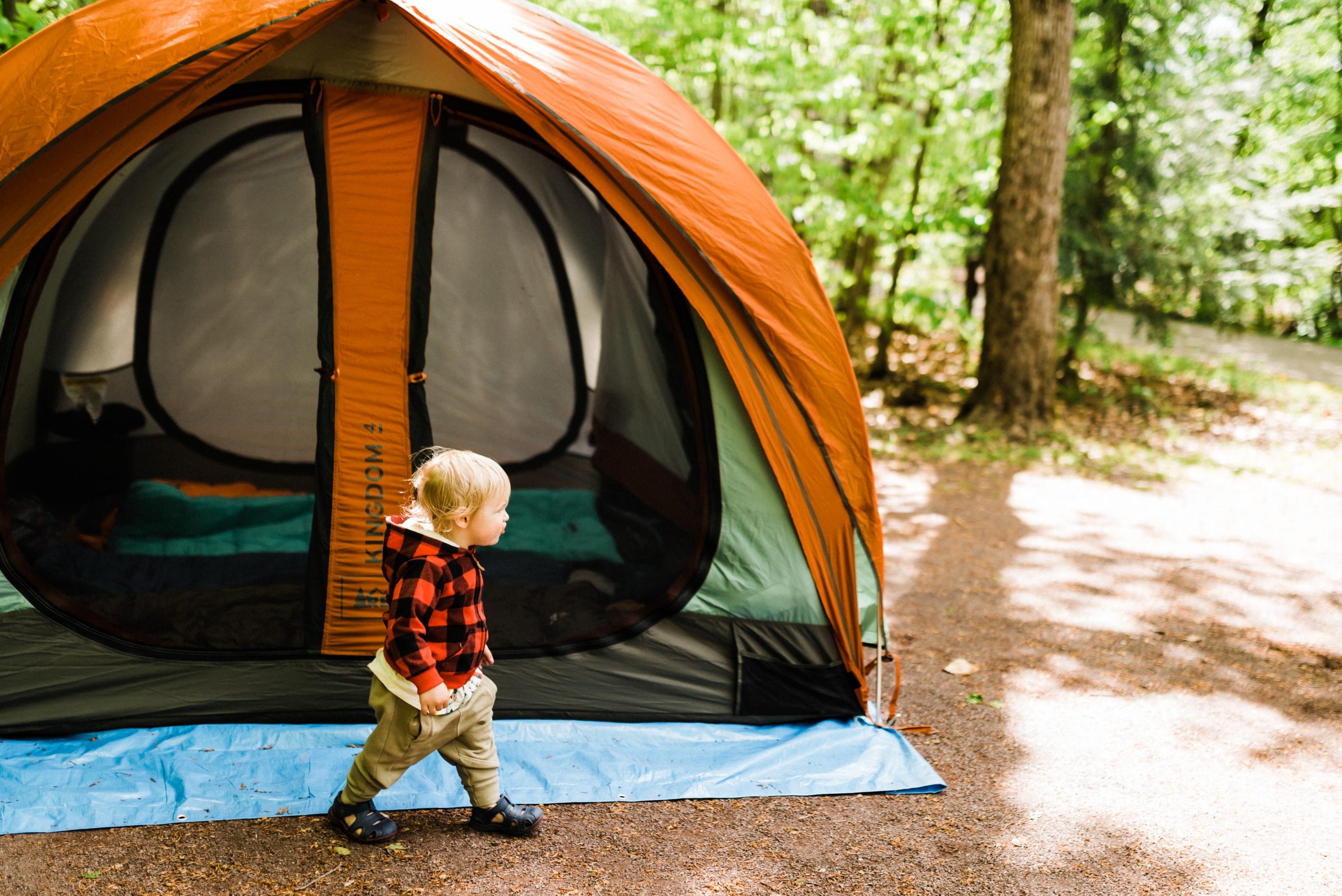The Ultimate Gear Guide for Hiking Elopements With Kids!
Hiking elopements with kids and adventure family sessions are loads of fun, but take a little extra planning. Ensuring you’re prepared with the right gear for your elopement or family session is the best way to prevent accidents, have fun, and feel confident while enjoying yourself! You don’t want to be worried if you or your children will be too cold, too thirsty, or too tired to reach the overlook. If you’re adventuring somewhere you’ve hiked before, you probably have a good idea of what you’ll need. But even if your elopement or family session location is new to you, or you’re new to hiking in general, this gear guide will make sure you and your children are properly prepared for the best day ever!
A hiking elopement or adventure family session with kids means even if you’re familiar with the hike or activity, your little ones are still learning the ropes. Below is a list of what gear you’ll want to have handy to ensure a safe and fun experience. You’ll find out how to choose which gear is best for you and your family, see examples from my experience of what gear has worked best, and get help choosing for yourself which pieces will suit your individual needs.
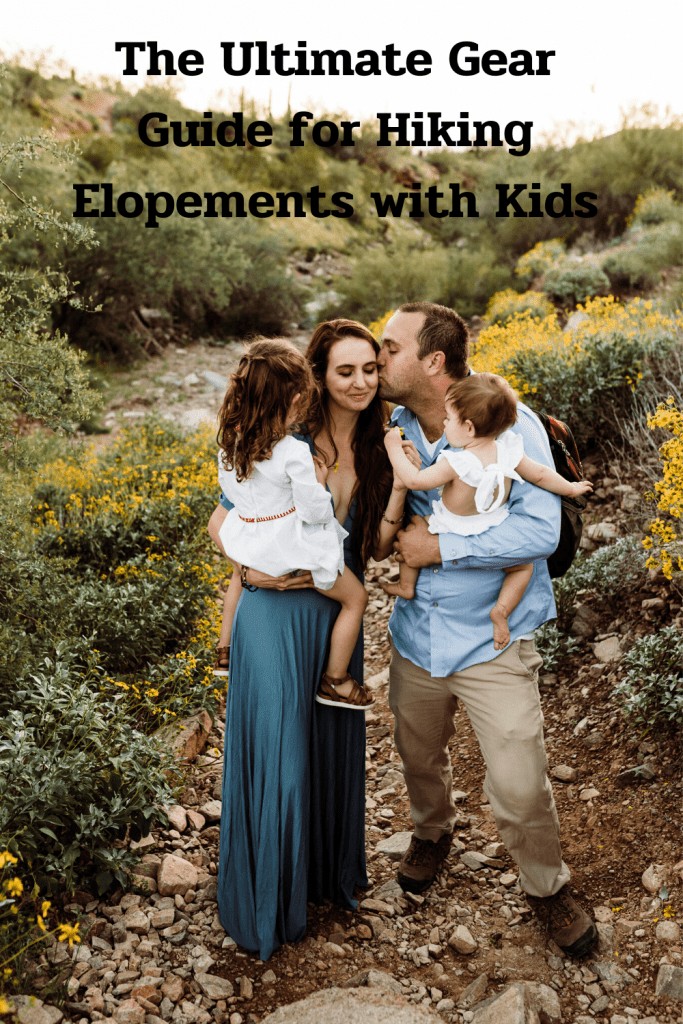
Gear Checklist for Hiking Elopements
- Comfortable shoes for kids
- Baby carrier (for extra-small explorers)
- Headlamp
- Hiking socks
- Layers
- Blanket or sleeping bag
- Sunscreen
- Water, Formula for babies (or even more water, if you’re still nursing)
- Snacks
Shoes for Hiking Elopements with kids
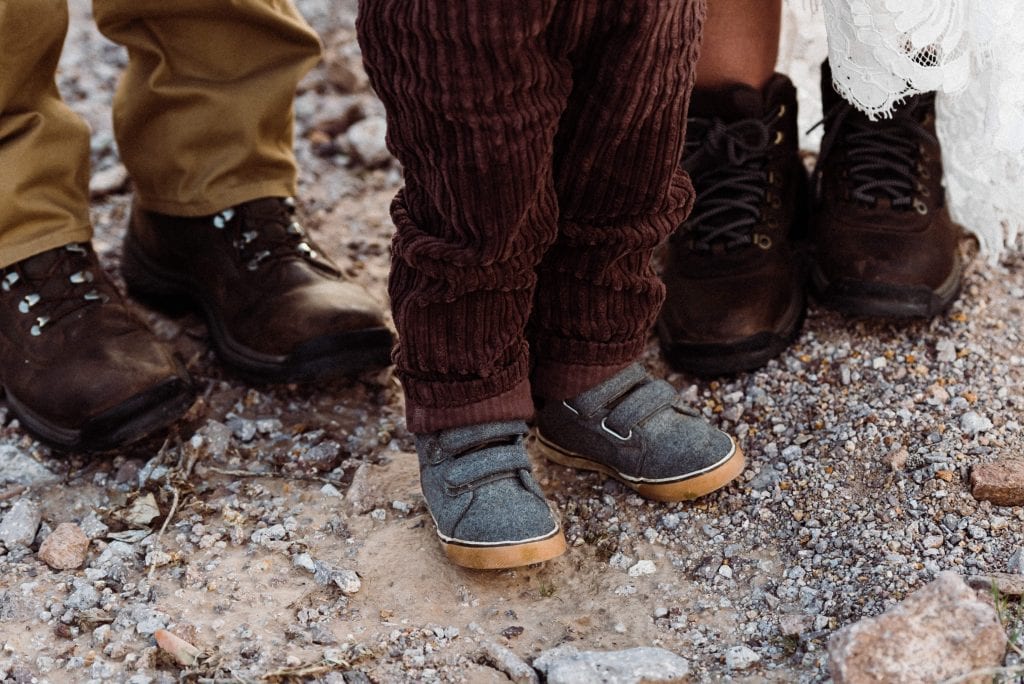
Let’s start with the most important thing – shoes! If you’re able-bodied, you can’t hike without putting one foot in front of the other! What you put on your feet is going to directly correlate to how enjoyable a hike can be. No one wants blisters on their toes – read carefully and learn how to choose the best footwear for your elopement! Location, personal needs, and length of hike will all be part of the consideration.
FACT: Don’t buy the reviews on shoes!
The right footwear is whatever is most comfortable for YOU! You can read all the reviews, ask all your friends, and make all the lists but ultimately you just need to go try shoes on.
Every hiker has different needs, and whether you will want more ankle support or not isn’t something I can answer. However, MOST people will benefit from shoes that fit four criteria: good tread, flexible, minimalist, and lightweight. If you’re looking for shoes that will serve you for many miles on the trails, you’ll want something that promotes a natural stride, gives your feet a chance to move naturally over uneven terrain, and has only enough protection to prevent rocks and roots from digging in. You should FEEL the ground beneath your feet – avoid shoes so stiff your arch can’t flex! Stiff shoes can cause serious foot pain over the course of many miles. And don’t forget to break in the shoes you choose BEFORE your elopement day!
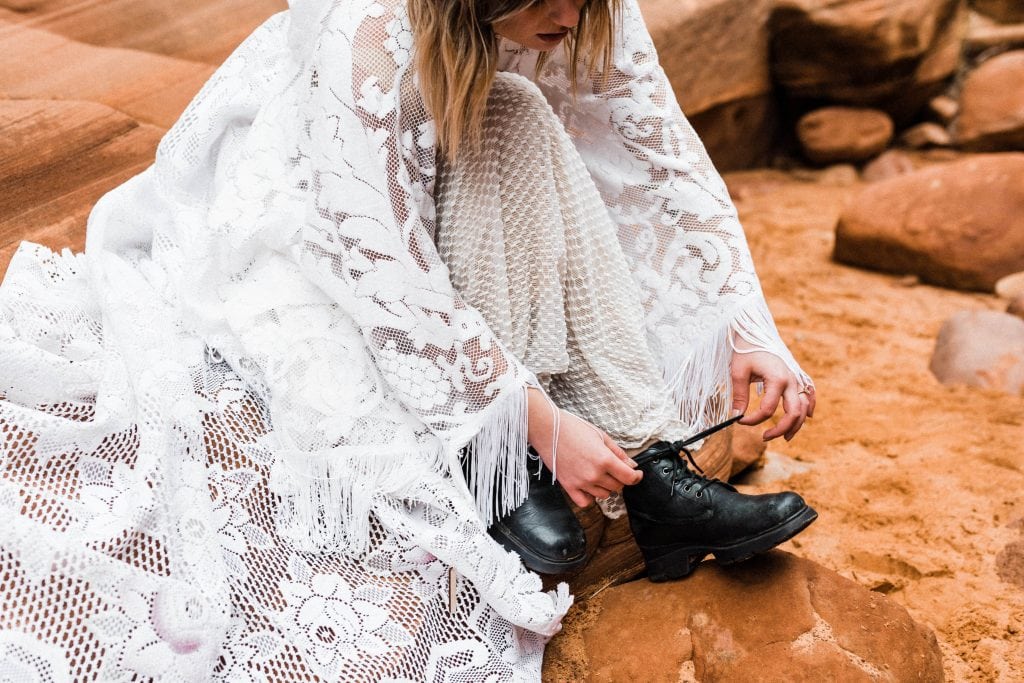
Minimalist & lightweight footwear is especially important for children
Your little one’s feet are growing, developing strength and balance, and learning how to physically navigate this world! Yes, kids grow out of things quickly, but if you do a lot of hiking as a family (or want to start), it’s worth choosing the right shoe. Heavy shoes require more effort to move, making little ones fatigue faster on adventures (meaning their big people also fatigue faster because they have to carry them). Heavy shoes also tend to be less flexible with thicker soles that make it difficult for children to navigate obstacles. Lightweight shoes, on the other hand, are both more flexible and breathable, providing support while keeping feet cool. Kids’ feet sweat 2-3 times more than adult feet, so a cool and breathable shoe is super important, especially in warmer climates! Choosing low top shoes for kids is also important because it allows ankles to flex and move the way they were meant to, meaning knees don’t have to compensate. To ensure they don’t have pain or discomfort in the future, and that their gait develops naturally, their feet need the room and flexibility required to develop muscle strength in the feet, ankles, and legs.
Barefoot is best
Walking barefoot, especially when you’re young, is the best way to develop the muscles necessary to prevent injury when you’re older. Obviously, unless your hiking elopement is through a plush grassy meadow or somewhere on the beach, you and your children are going to want shoes! The next best thing to barefoot is a shoe that mimics barefoot walking – wide toe box, thin and flexible sole, and zero-drop platform (a sole that is flat, rather than being a bit higher in the heel).
Summary: Look for lightweight, breathable, flexible footwear for your hiking elopement, and break it in!
My Top Choices for Elopement Footwear for Children:
Best for flexibility & durability
The perfect combination of being flexible and durable, this children’s shoe by Splay has all of the characteristics of a barefoot shoe, plus a velcro strap and tongue that pulls back making them easy for preschoolers to put on themselves.
Best minimalist shoes for kids
Softstar moccasins are handcrafted in Oregon, and the sizing is extremely flexible coming in narrow, regular, wide, and extra-wide, which is so important when you’re trying to fit small kiddos with wider feet for shoes. For more cushion and warmth, removable sheepskin innersoles can also be purchased.
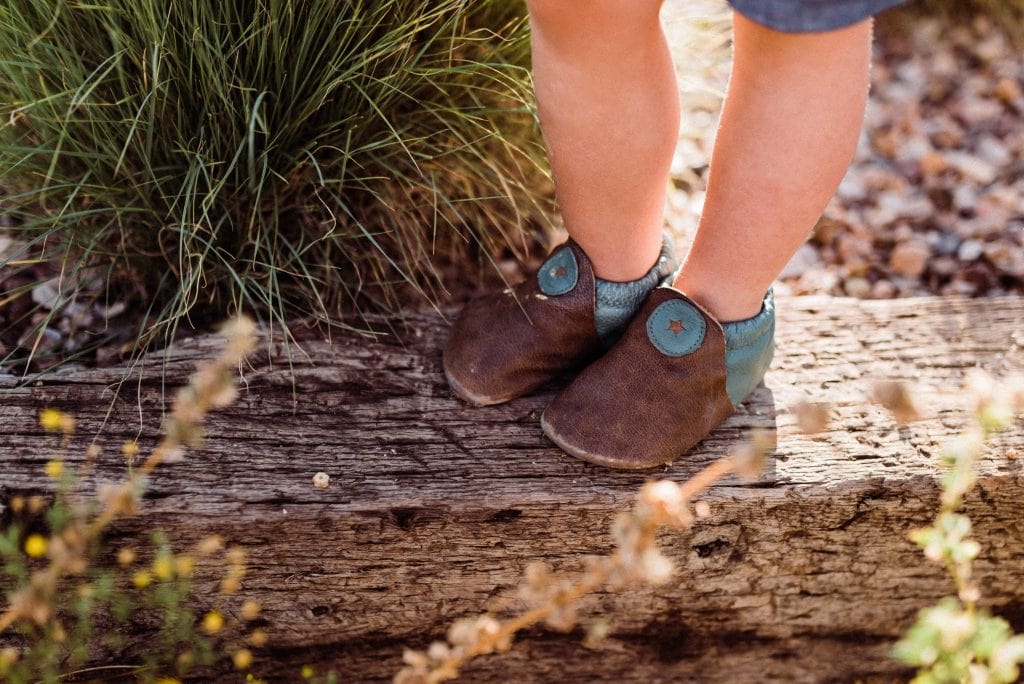
Best kids shoes with good traction
The Xero Prio shoe for kids has a flexible rubber sole that provides protection, traction, and still allows little ones to receive feedback from the terrain.
The winter version of these Wildling shoes and boots feature a wool lining and exterior to keep feet extra toasty and dry. The shoes made from Washi (a paper-type material from Japan) are durable, breathable, and dry quickly after getting wet, making them a perfect choice for summer hiking elopements.
Best if you want a thicker sole
Merrell’s Bare Steps line features a shoe with a bit thicker sole than the other minimalist shoes on this list, but still features a wide toe box and flexible grooves on the outsole to provide a barefoot feel.
Best for lightweight when barefoot isn’t an option:
Carriers for Hiking Elopements with kids
Hiking elopements with children present their own set of challenges, and an added level of complication can sometimes be that our littlest hikers simply can’t make the journey yet on their own two feet. This is where an awesome hiking carrier can come in handy! However, unless you’re an extremely experienced hiking family, the number of options on the market for carriers can be overwhelming. There are super stowable soft carriers, and then hard carriers with a more structured frame, like a backpacking backpack. How do you know which one to choose? Well, I’ve outlined the pros and cons of each kind of carrier to help you pinpoint what is best for your family and your elopement!
Soft Carriers
Soft carriers are exactly what they sound like – there’s no hardware and construction to them. They are perfect for smaller babies who can’t yet ride in a more structured carrier, but they also work well for those with larger babies that are only going on a short hike. I can’t tell you exactly what mileage or age is the cutoff for using a soft carrier, so if you’re on the fence, you might want to at least try on both types to feel the difference.
Pros of a Soft Carrier:
- No age limit – even newborns can be carried safely
- Carried in front and against your body, your little one can hear your heartbeat and breathing, which can be really soothing
- It’s easier to monitor your baby’s temperature and to keep them warm
- Keeps really young ones close and in your field of vision, which can be reassuring for parents
- Allows you to nurse on the trail
- Versatile and can be used on your back for older babies
- Has a lower center of gravity, which may make some parents feel more stable
- Can be shoved in a backpack, diaper bag, or small space for easy stowing, and can be easily pulled out when needed
- Less expensive than a framed carrier
- So many options, you’re sure to find one that “feels” right
Cons of a Soft Carrier:
- They can get really uncomfortably warm in the summer
- If worn on the back, some babies might be too low for them to see over your shoulder
- No or very little sun/rain protection
- No gear storage
My Top Choices for Soft Carriers:
My go-to baby carrier for hikes
The Happy Baby is my very favorite baby carrier; these linen carriers are a dream to wear in the summer time. They are easy to get on and off, and come with a protective hood, which is rare in soft carriers. The original carrier model can be used to carry newborns without needing to purchase an additional insert, and can be used to carry your child until they are up to 45 pounds. After that, their toddler option allows you to wear your child from 25-60 pounds. Note: the Original Happy Baby and Toddler Carriers allow only front inward facing and back positions, but the Revolution Carrier also has a front outward facing carry option.
Perfect for a day hike with a newborn
Not for racking up the miles, but perfect for a day hike (especially with a newborn). Solly Baby’s soft silky wraps feel so nice for you and your baby, and can be wrapped as tight as needed. Just keep in mind that the baby should be wrapped high enough to make sure airways are always clear. This carrier is perfect for shorter jaunts with babies during those first few months.
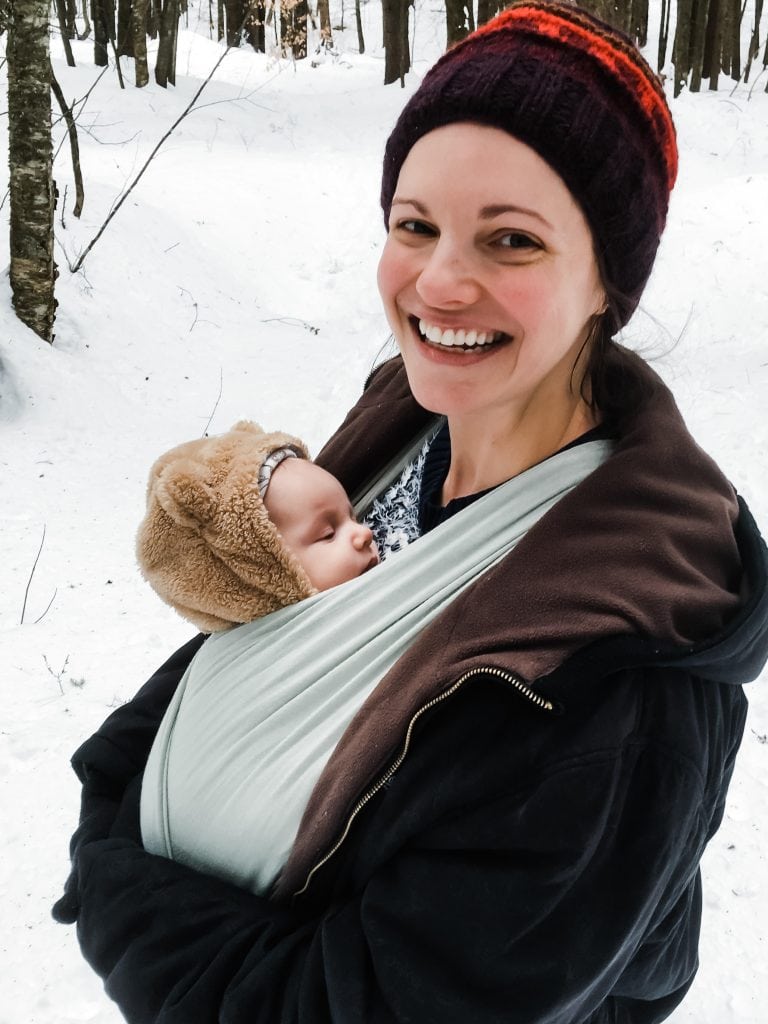
Perfect for adjustable carrying positions
Tula’s Free-to-Grow Baby Carrier accommodates newborns, infants, and young toddlers ranging from 7-45 pounds. Back and front carry options allow ergonomic positions for comfortable carrying and healthy hip and spine development for your baby. Adjustable, padded shoulder straps and breathable material make this comfy for both you and your kiddo. However, this one doesn’t allow for front outward-facing carry.
We use the Ergobaby Omni 360 and love it. It’s a bit bulkier than the Happy Baby carrier above, but has more carry position options, and is still super comfy. They are advertised as the carrier when you need every option, and that pretty much sums it up. They can be used to carry newborns (without an insert) to toddlers, and have many carry position options, front carry inward facing, front carry outward facing (from 5 months +), and hip and back carry (from 6 months +). They also come in a mesh breathable version for cooler carrying in warmer climates. Finally, the straps are crossable, providing additional lumbar support.
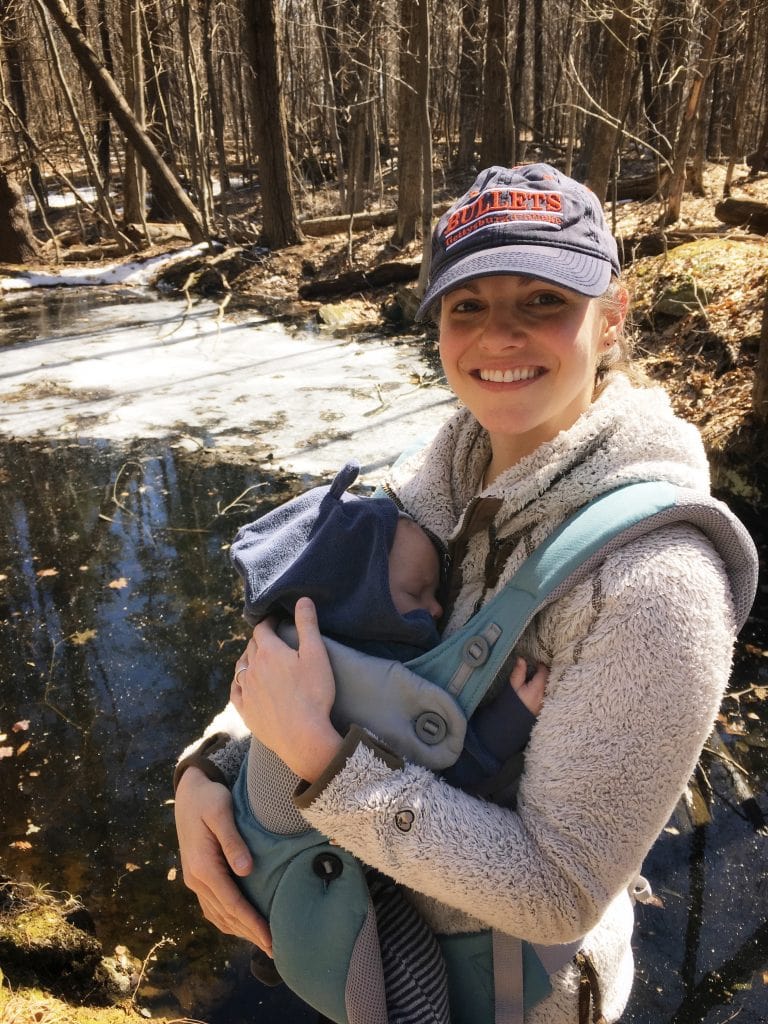
Framed Carriers
Hardshell or framed carriers sit much higher on your back than the soft carriers. They are structured, like the name suggests, but this means they are not suitable for very young babies, who need more protection and a more bundled hold. Framed carriers are meant to be the backpacker’s solution to carrying children on hikes, and you could go all day with the right carrier and a willing infant. That said, they can also be frustrating to deal with on a very short hike, and it can be helpful to have a second set of hands to adjust straps and make sure your baby is secure.
Pros of a Framed Carrier:
- You can hike much longer with a more supportive weight bearing capacity
- Has storage options (all those snacks have to go somewhere!)
- Babies and toddlers sit higher in these so they can see better and appreciate the view
- The baby is held farther from your body, allowing air flow and a cooler hike
- Many offer sun and rain protection
Cons of a Framed Carrier:
- Can’t be used with newborns or smaller babies (generally cannot be used safely before 6+ months of age)
- Center of gravity is higher and can make a wiggly baby hard to balance
- Since your baby isn’t against your body, you’ll be less attuned to their body temperature on a cold or hot day
- Can be difficult to put on and take off
- Heavier, bulkier, and can’t be easily stashed away when not in use
- More expensive
My Top Choices for Framed Carriers:
Perfect for larger babies and toddlers
The Deuter Kid Comfort Child Carrier is super comfortable for both parent and kiddo with a sturdy metal frame that accommodates a growing child, a padded hipbelt, and a mesh back panel for ventilation. The arched profile frame transfers 70% of the load into the hip fins for increased comfort. A soft, removable pillow and side support cushions support sleepy heads encouraging mid-hike naps. The side entry option and roomy suspended child seat make this the best option for larger babies and toddlers.
Perfect for smaller toddlers, with more storage capacity
I love my Osprey backpack and wanted to love the Osprey Poco Plus Child Carrier for my kiddo, but when it came to fitting us both, the Deuter was a much roomier seat for my two-year-old. The Osprey felt incredibly snug and constricting in comparison. This pack is lovely though and for a smaller child would likely be perfect. Plus the storage is better in this one (at 26 liters) than the Deuter. That said, it lacks the side entry option that is invaluable on treks with toddlers.
Summary: The age of your child, length of the hike, and your comfort with carriers is going to strongly affect whether you’d prefer a soft or hard carrier for your hiking elopement. If using a soft carrier with a front carry option though, make sure your baby is close enough to be kissed on the head, and that their airways are always open!
Other Gear for Hiking Elopements
Headlamp
You always want to hike with a headlamp or a good flashlight, even if you’re planning on being back before the sun sets. I consider this a safety feature that is just as important as a first aid kit or cellphone because you always want to be prepared for a hike taking longer than expected. Also, if you’re out before sunrise or after sunset, headlamps are essential for making a hike safe, and the photos at these times are always stunning! Bring extra batteries with you or make sure your headlamp is fully charged, if it’s the rechargeable type. You may need a headlamp for safety, but kids appreciate bringing their own for the fun factor.
A Perfect Hiking Elopement Headlamp
Hiking Socks
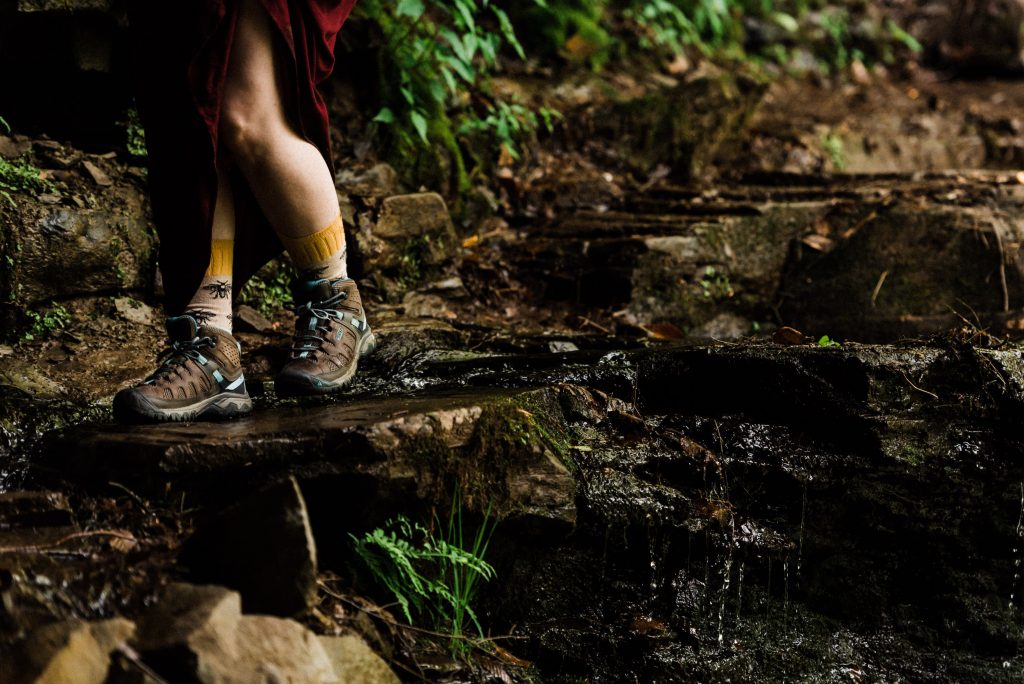
Wool socks are an essential part of your hiking gear. The best socks prevent blisters, regulate heat, and allow you to hike all day in comfort. There are many brands out there, but Darn Tough, Smartwool, and Wigwam are my favorites.
The Best Wool Socks for Hiking Kids
Clothing Layers
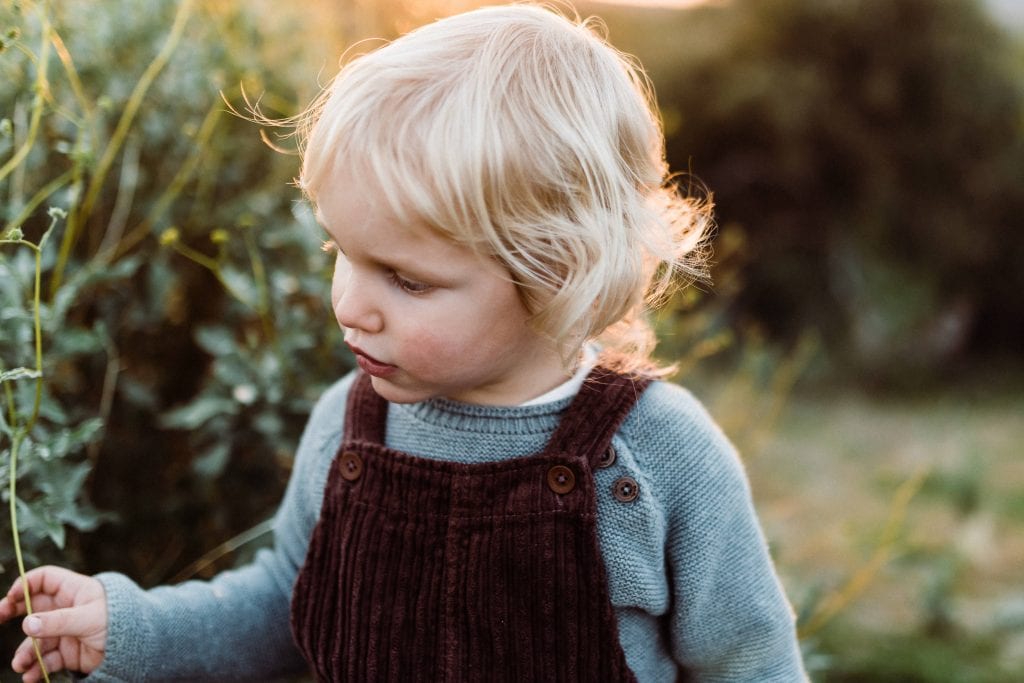
Base layers, knits that can be easily removed, and clothing items with texture, like corduroy, photograph lovely and keep little ones warm, but not too warm.
Layers are a must, no matter the time of year! If you’re wearing a dress, I always recommend a solid pair of nude leggings to keep you warm without standing out in photos. Under suits, a wool base layer will keep you warm without feeling stuffy. Look for merino wool to get the performance of wool with the comfort of cotton. It’s not stiff and scratchy, and wicks moisture much better than other materials.
I cannot stress layers enough. For you and your children, flexible layers can be the difference between a meltdown due to discomfort or the ability to stay cozy and happy all day outside. Down jackets, chunky sweaters, wool shawls, small blankets, scarfs, gloves/mittens, and beanies are all essential if eloping during the winter, at high altitudes, or even in the desert in the evening. The textures of chunky sweaters and scarfs photograph beautifully, and you’ll photograph more beautifully if you’re comfortable, too. Hand warmers can do wonders and they’re so easy to stash in pockets, gloves, mittens, or even in between layers when the weather becomes a little too cold for comfort. Toe warmers are worth considering, though harder to stash in tight shoes. In the summer, sun hats are a must for kids on long exposed hikes.
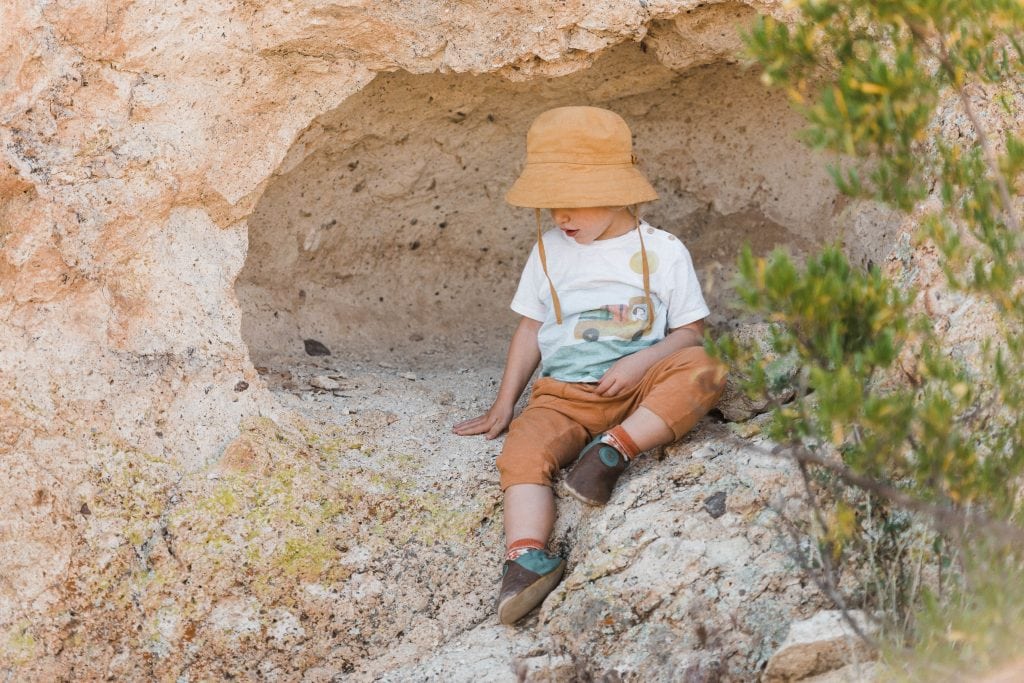
Base Layers for Kids and Babies:
Chasing Windmills thermal long johns
The Best Merino Base Layers for Babies
This bunting can double as a sleeping bag without needing to worry about your little one getting swallowed up:
The Most Versatile Outerlayer for Kids
Blanket or Sleeping Bag
Bring along a lightweight blanket or sleeping bag even if it isn’t cold out! It can make for a beautiful addition to cozy pictures, or serve as a dirt-free place for your little one to hang out while you’re a couple steps away getting some individual portraits. If it is cold, a sleeping bag that packs down easily can be a perfect piece of gear for your kid to snuggle up in, if they get chilly or want to sit down.
My Favorite Blankets For Style
The Most Lightweight Hiking Blanket
My Favorite Children’s Sleeping Bag
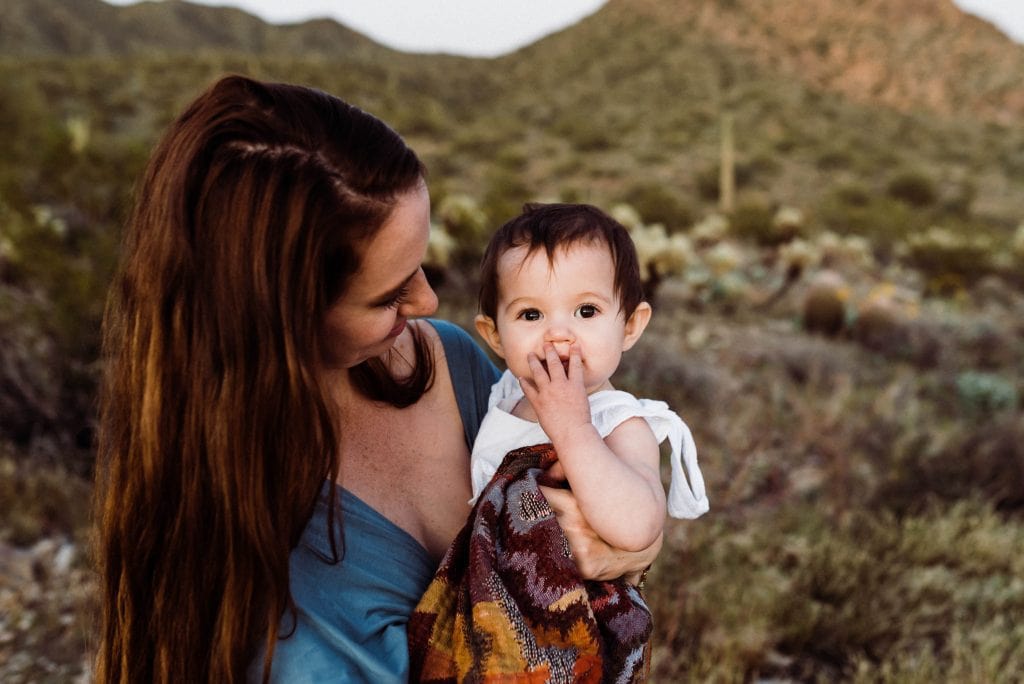
Sunscreen
Sunscreen isn’t necessary only in the summer! A little dab on exposed noses in the winter can help when the sun is reflecting off freshly fallen snow. Sunscreen, or even just a little bottle of lotion, can also help if the wind picks up and cheeks become red and chapped. It really is a basic necessity during hiking elopements with kids.
Baby safe sunscreen that’s great for everyone in the family
Water & Snacks
This one is the most obvious yet the most overlooked necessity when hiking with children. My rule of thumb is to always have one more meal on hand than you think is necessary, and as much water as you can comfortably carry. Even when it isn’t hot out, hiking depletes your water reserves and hangry isn’t just a result of lack of food. Adequate hydration and regular snacking are essential for keeping morale high during a hiking elopement. Never underestimate the power of a well-timed cracker in keeping kids from getting cranky.
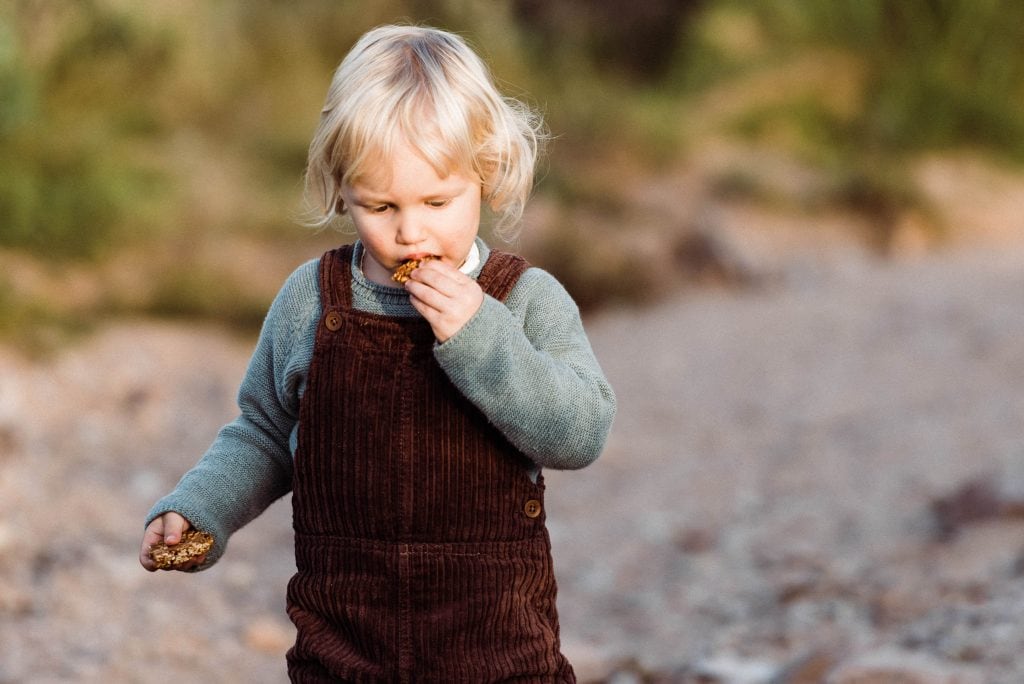
Never underestimate the power of a snack for calming a fussy kid.
Now that you’re prepared to check these things off your gear list, it’s time to get down to planning the specifics!! Need some inspiration? This post has loads of ideas for including kids in your elopement day!
Each location and each family is going to be a little different. The items listed above are essential for all hiking elopements with kids, but let’s talk about what you need for your dream location! I love guiding couples and their families through every step of the planning process, from location scouting to double checking that everyone is having fun midway up the trail.

